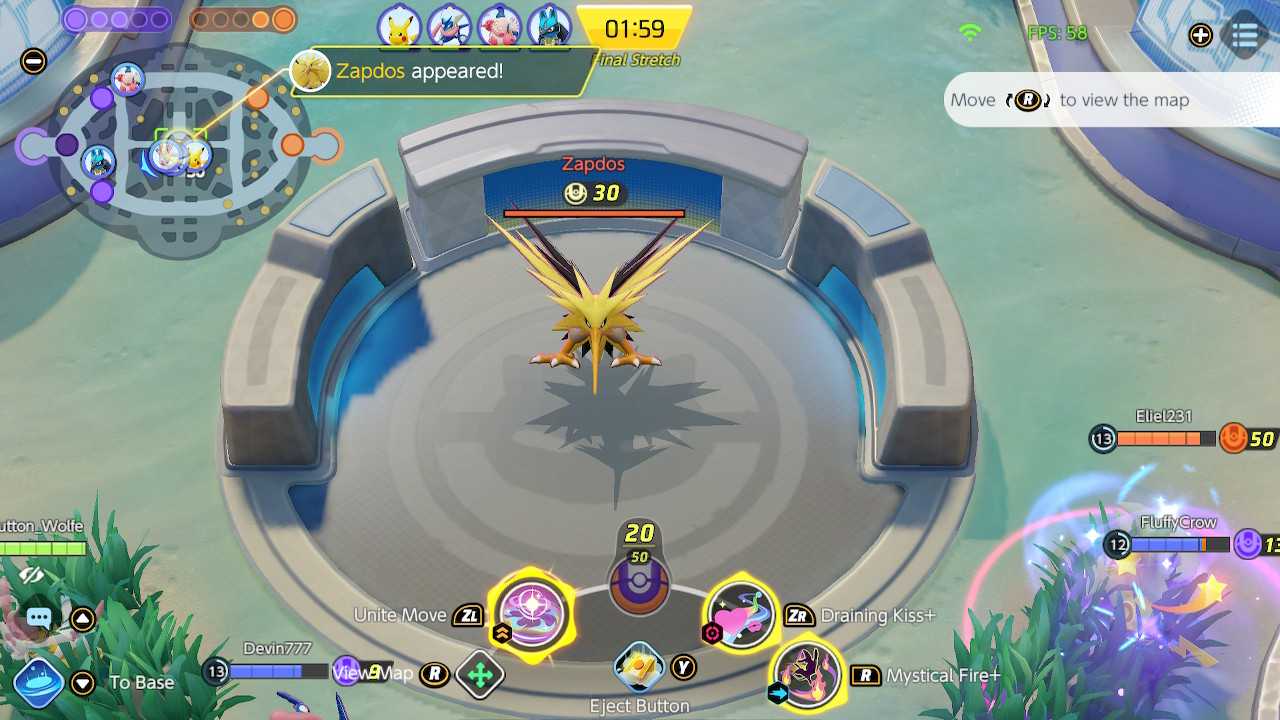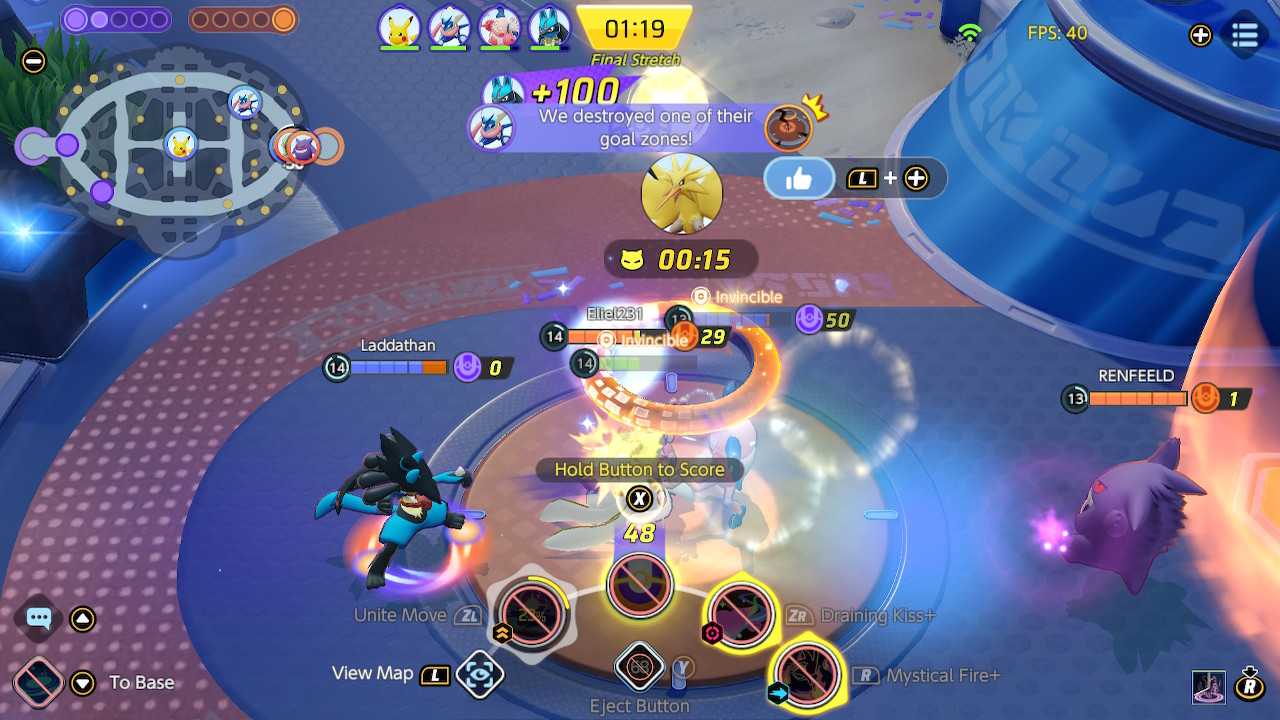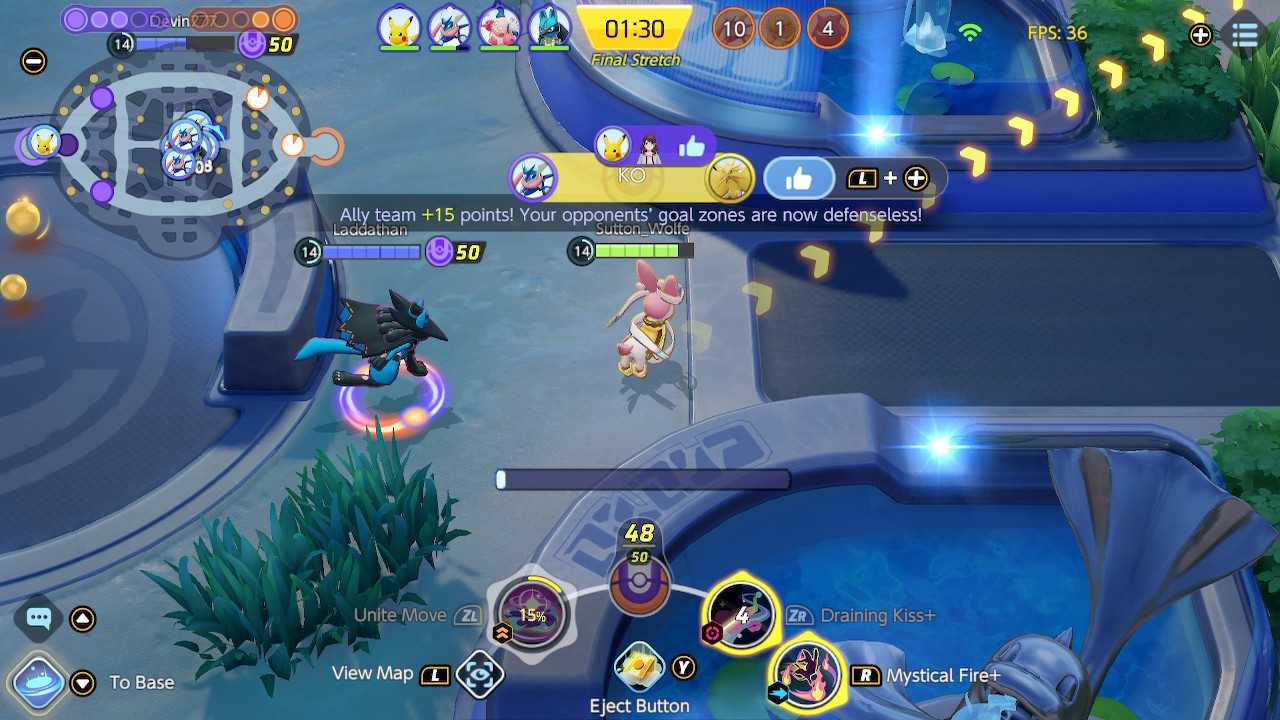United by Zapdos: A Guide to Pokémon UNITE's Volatile Legendary
On Remoat Stadium, Zapdos’ arrival indicates the game is reaching its climax. This guide will explain how to navigate around the Legendary Pokémon and secure this volatile objective!
On Remoat Stadium, Zapdos’ arrival indicates the game is reaching its climax. This guide will explain how to navigate around the Legendary Pokémon and secure this volatile objective!
In Pokémon UNITE’s Remoat Stadium—the traditional map used for both standard and ranked matches—players experience ten minutes of fast-paced, highly-interactive MOBA gameplay. This explosive action culminates in the eighth minute, as the legendary Pokémon Zapdos spawns directly in the center of the stadium.
Able to be slain by either team, this giant electric bird grants incredible boons to whomever secures it, so much so that some games are ultimately decided by which squad manages to do so successfully. As such, let’s take a look at this legendary Pokémon, why it’s so divisive, and how to play around this quintessential quarry.
Eight minutes into a game played at Remoat Stadium, players are alerted to the legendary Pokémon Zapdos having spawned in the center of the map. Similar to defeating Rotom and Drednaw—the map’s other two neutral objectives—securing the last hit on Zapdos nets your team points of Aeos Energy for scoring, alongside an external effect on the map itself. In the case of Zapdos specifically, landing the final blow will grant the respective player thirty Aeos Energy automatically, accompanied by twenty more points to everyone else on their team. This itself is nice, but it pales in comparison to the buff this giant lightning bird provides.

From the moment Zapdos is defeated, the opposing team’s goal zones will become vulnerable for the next thirty seconds of the match, meaning that points can be scored almost instantaneously rather than with the usual charge-up time. This applies to all of the opponents’ goal zones, though do be aware that you still only have access to the outermost zones that haven’t been destroyed. Seeing as points scored are doubled past the two-minute mark, however, destroying the outer zones with the points Zapdos grants your team is far from difficult (provided that you don’t get defeated beforehand). This can be the cause for a massive swing on the scoreboard late in the game, especially if multiple team members get to take advantage of this effect.
As Pokémon UNITE was released and players took to ranked battles to show off their skills, many were quick to point out that this Zapdos buff is terrifyingly strong. Players lamented games of utter domination for eight minutes, only for the opposing team to take a wild gamble and manage to snipe the last hit on Zapdos despite all odds. Since they were winning the game handily for the entire time, all of their team’s goal zones were still left standing, meaning that with Zapdos’ buff the enemy team could score literally hundreds of points by destroying all of them in one fell swoop.
Screenshots were posted displaying post-game point graphs that showed complete annihilation for eight to nine minutes, only for an almost laughable mountain to spike upwards and barely steal the win, all because someone on the enemy team “got lucky and sniped Zapdos”. Even players that won through these means found it comical, and the words “Wow, we didn’t deserve to win that game.” accompanied nervous laughter among many friend groups (including my own).
A common complaint began to arise that Zapdos served little to no purpose for the winning team, simply making them sweat no matter how favorably the game had been for the first eight minutes. This sentiment was only strengthened by players discovering that prior to the game’s September twenty-second patch, securing Drednaw before the two-minute mark actually reduced your team’s damage dealt to Zapdos for ninety seconds—by a whopping fifty to fifty-five percent at that. Thankfully, following the aforementioned patch this debuff no longer exists, but one can understand the questions this would raise.
Unlike other MOBA games, where special abilities or spells exist specifically to execute and secure neutral monsters (like Smite, for any of you League of Legends players out there), Pokémon UNITE does not have such a feature. There is the Fluffy Tail battle item, however this merely increases the damage a wild Pokémon takes and stuns it for a bit, rather than doing a burst of damage to secure it. That’s quite the important distinction, as it means that no matter how far ahead your team may be, there are no guarantees; opponents can steal the Zapdos buff from right under your nose if you aren’t exceptionally careful and precise. Whereas in other games one specific player on each team could be tasked with securing these neutral objectives through a special ability, in UNITE all five enemies can be a legitimate threat to steal Zapdos. This means that a sometimes-uncomfortable amount of difficulty and luck gets added to securing the big yellow bird—leading to a brief period of outrage from players experienced in other games who weren’t accustomed to this concept in their previous titles.
Thankfully, as time passed and the game gained traction, Pokémon UNITE players began to grow accustomed to the mechanics of securing and utilizing Zapdos. The patching-out of the Drednaw debuff helped as well, of course, but accepting that Zapdos was intended to be a legitimate comeback mechanic was a necessary, albeit time-consuming trend. That’s all well and good, of course—I’m always relieved when games get less hate—but getting over the controversy doesn’t make securing Zapdos in-game any easier. Whether playing from a lead or trying to make a comeback, the lightning-feathered menace is still often the biggest impact point of the game, so let’s take a look at some strategies for making the most of it.

As previously mentioned, there aren’t any universal abilities that specifically serve to secure wild Pokémon. The Fluffy Tail battle item is handy for trying to increase damage dealt to them for a short period of time, but without a specific, immediate execute button on hand you risk having your quarry stolen with relative ease. In the case of Zapdos this is especially intimidating, so finding other ways to swing the odds in your team’s favor is pivotal to successfully landing the final blow.
The simplest (although not necessarily the easiest) method to ensuring Zapdos doesn’t get stolen from you is ensuring that no enemies are on the map to steal it from you. Winning a decisive teamfight to wipe the enemy team will immediately reward you the legendary bird—so long as you keep enough players alive to be able to defeat it. Regardless of whether you’re ahead, behind, or dead even in the current game state, there are some general guidelines to follow for ensuring a beneficial teamfight.
First and foremost, getting to the middle of the map where Zapdos spawns before the opposing team is very helpful. There are clumps of brush scattered around this area, perfect for setting up ambushes. Vision (or in this case the lack thereof) is your friend, and forcing the opponent to walk towards you blindly greatly increases your chances of picking somebody off or initiating an advantageous fight.
Next, if you know Zapdos is spawning soon, then do whatever you can to save your Unite Move for the upcoming skirmish. These abilities are hugely impactful, and the difference they make in teamfights is unquestionable. For the same reason, trying to save battle item cooldowns among your team members is beneficial as well. Make sure not to attack Zapdos or get too close to it during the fight if your team gets to the area first. The legendary Pokémon deals a surprising amount of damage over time, and it can be a huge nuisance for your backline to avoid it while trying to fight. Finally, make sure you account for where the enemy team members approach the central area from. Keep an eye on the mini-map to ensure you have vision of all five enemies so you know what angles they’ll appear from so nobody gets the drop on you!
Another way of playing around Zapdos is manipulating the state of the game to your favor and understanding what it means for both teams. Is your team solidly in the lead? If so, then the opponents will likely attempt to use Zapdos to stage a comeback. If you’re behind, then the opponents will likely try to stop you from doing so. What neutral objectives besides Zapdos are currently available, if any? How many goal zones are still active for each team? Identifying these pieces of information leading up to Zapdos spawning can greatly influence your team’s decision-making in this crucial stage of the game.
An interesting concept present in Pokémon UNITE is that the full scoreboard is not visible at any point during the game. You can, however, view how many takedowns and assists each player has, and this alongside taking note of how many goal zones are still active for each team can help you make somewhat educated guesses about the score. In addition, the game’s announcer will alert all players near top of the screen to an approximation of the score at the five-minute mark (and every minute thereafter), letting everyone know if one team is winning, if one team is winning by a significant margin, or if the game is comparatively close. Through all of these factors, one can generally have a sense of whether their team is winning or losing at a given point in the game, helping to influence their decisions moving forward.
When significantly behind, taking Zapdos is the primary comeback mechanic. Attempting to crawl back into the game over time is all well and good, but in dire game states this will likely not be enough. The enemy will know that your only chance is securing Zapdos, and will likely try to meet you there early to contest it. They will likely be in a stronger position to win a subsequent teamfight, so engaging in such a battle is not recommended unless you can secure a truly advantageous location in the center of the map beforehand.
Alternatively, as you know that the opponents will likely converge on the center of the map, setting up ambushes along the way to pick off one or two enemies can help swing momentum in your favor right before Zapdos. As the game goes on, respawn timers will get increasingly long, meaning that these picks can grant you a significant period of time with a numbers advantage, allowing you a small window to pressure the big yellow bird.

When significantly ahead, taking Zapdos is not required for you to win the game. You simply need to make sure the opponents don’t defeat it and stage a comeback. As mentioned previously, teamfights can certainly blow the game wide open in this type of scenario, and taking Zapdos would indeed end the game in your favor, but doing so runs the risk of the opponents stealing it and turning the tables. As such, sometimes a safer method can be achieved by preventing Zapdos from being taken at all. When ahead, usually some of the opponents’ goal zones will have been destroyed by the time Zapdos spawns. This provides your team with some extra space to work with, as you can encroach upon the opponents’ half of the map and steal their resources. The more you can do this, the greater the difference in experience will be between the two teams. By the time Zapdos spawns, if your team is significantly higher-leveled than your opponents, then even if they attempt to force a fight around Zapdos you will have a significant advantage. If they don’t force a fight due to your pressure around the map, then you will win out anyway due to your existing lead and superior access to resources.
Speaking of resources, Zapdos isn’t the only wild Pokémon with a large effect; Rotom and Drednaw are the two large pre-Zapdos objectives present on the map. Although they despawn as Zapdos enters the map, taking either or both of them soon before Zapdos spawns can aid your chances of securing the giant lightning bird greatly. As was just noted above, experience is a big deal when considering strength in fights. As such, the bonus experience granted to the team who defeats Drednaw is a large boon and, alongside the shield it also bestows, it works a great deal to ensuring your advantage in fights around Zapdos’ center area. This can be incredibly useful regardless of whether your team is ahead or behind, so teams that are struggling leading up to Zapdos should heavily consider making a move to secure this tanky turtle!
Rotom, for its part, is less immediately useful in relation to Zapdos itself, but it certainly isn’t worthless. Pressure in different points around the map is a valuable resource, and so securing Rotom to move down the top lane and threaten its nearest goal zone can be a solid way to pull your enemies around the map while the rest of your team focuses elsewhere. For teams that are behind but not cripplingly so, this can provide an avenue to equalizing the scoreboard, helping to balance out the game state before Zapdos spawns. For teams that are ahead, it can create a difficult scenario for opponents, where they must choose between wasting time answering the Rotom push (leaving less time to pressure Zapdos) and ignoring it in favor of Zapdos (risking the destruction of a goal zone as a result of the unanswered Rotom).
While Zapdos is the primary objective on the map, don’t forget about Rotom and Drednaw. They aren’t quite as powerful as the legendary Pokémon, but they both pack a punch in their own right, and utilizing them soon before Zapdos spawns can provide a much-needed momentum boost in the game’s final stages.
All in all, Zapdos is an incredibly volatile aspect of Pokémon UNITE. It can completely flip a game on its head, and it ensures that a comeback is almost always possible regardless of the state of the game. At first, many found this to be unhealthy for the balance of the game, but over time understanding of Zapdos’ role overall has expanded, and its identity as a necessary mechanic has become more and more solidified throughout the game’s early lifespan. As players learn more about the legendary Pokémon and its impact, new and improved strategies form to ensure that such a pivotal resource be secured. Whether it’s straightforward teamfighting, objective-based pressuring, or something entirely different, Pokémon UNITE offers a wide array of possibilities for gameplans and playstyles, and that’s part of what makes the game special. Despite the initial hesitations around it, Zapdos is a vital aspect of UNITE’s main game modes, and playing around it successfully requires practice, understanding, and patience. Stay calm, be perceptive, and utilize every resource at your disposal to secure this volatile, electrifying objective!